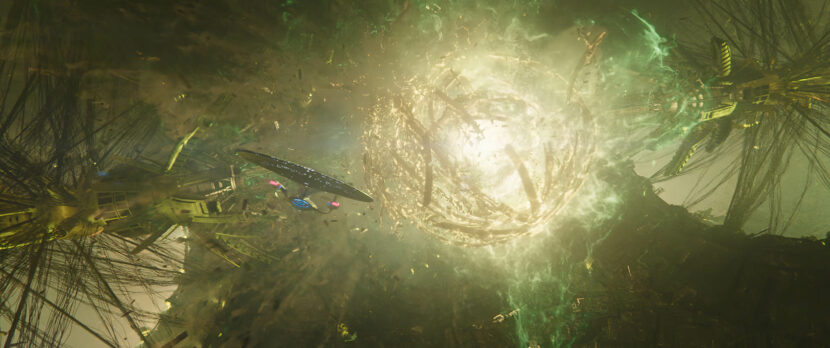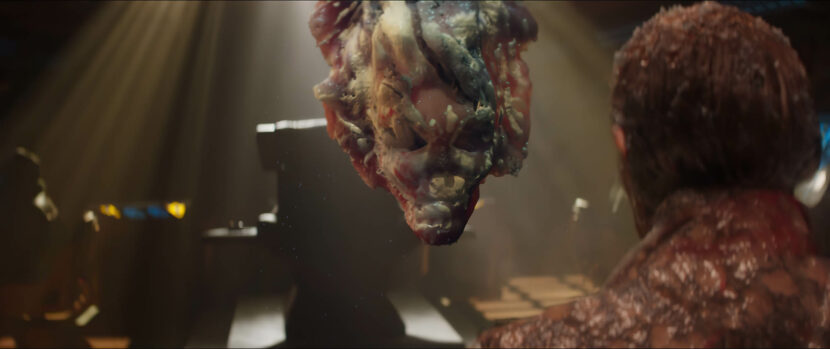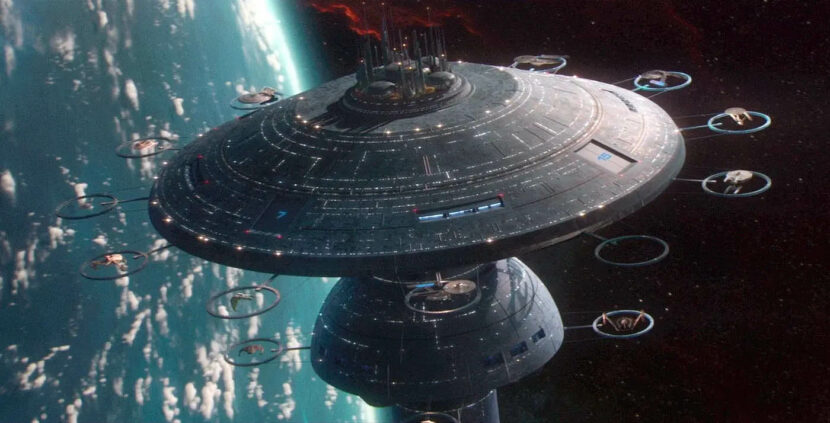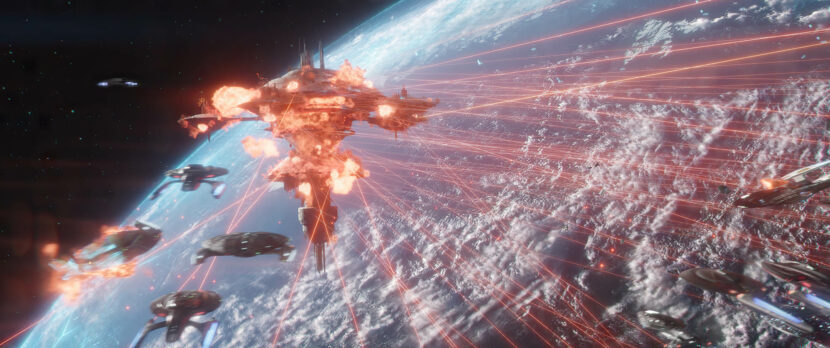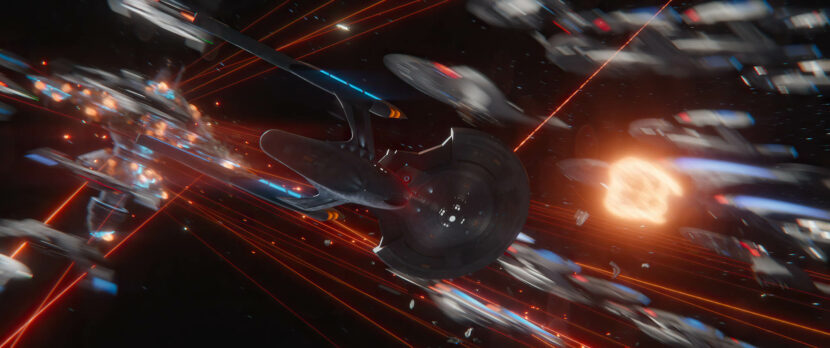The original Star Trek: The Next Generation (TNG) created by Gene Roddenberry first aired on September 28, 1987. It ended this run on syndication on May 23, 1994, after 178 episodes over seven seasons. The show was significant in many ways, but especially in VFX where the show was a lighthouse for digital visual effects. While feature films were still primarily doing VFX comps using an optical printer, modern VFX was being developed in a hand full of LA-based VFX houses. We know as fxguide founders and friends such as Jeff Heusser and Peter Webb were in the digital trenches working on those shots. Companies like CIS, Post Group, Digital Magic and others were pioneers with shows such as TNG, Deep Space Nine, and Voyager.
Run the clock forward to 2023 and so much of that tradition, innovation, and deep affection for the craft is reflected in Picard. This powerful legacy is something that is not lost on the current visual effects team. We spoke to Jason Zimmerman (JZ), the show’s Supervising Producer / Lead Visual Effects Supervisor and Brian Tatosky, Associate Visual Effects Supervisor. Brian commented that Rich Throne, who was pivotal at The Post Group, Digital Magic, and Fox VFX in those days of the original ST-TNG, used to teach a UCLA extension class on visual effects. Rich Throne would get key members of the Trek crew to guest lecture in his course, people such as Dan Curry (see our fxguide interview with Dan). Dan Curry pioneered high volume, high-quality episodic television visual effects and as a result was nominated for an Emmy 15 times and won 7 times. Brian at the start of his career actually used to set up the video projectors for lectures at UCLA. “And so I did his class remotely through that,” he explains. “I got to watch that digital transition and that first little inkling of CG being brought into episode shows and how they did it.”
Goop face
Before the final reveal of who is really behind the attack on Star Fleet, whoever was behind the attack spoke via a meat-like morphing head communication device, nicknamed by the VFX team ‘Goop Face’.Picard Season 3 showrunner Terry Matalas had a very strong vision of how the visuals for the ‘goop face’ needed to look. Vadic played by Amanda Plummer is a shapeshifter who communicates with a ‘goop face’ version of the Borg Queen. The effect is all traditional animation to the final audio. “Good old keyframe animation still does a lot, – especially when you’re emphasizing character and emotions.,” says Brian. “The more non-realistic character you get, – the more opportunities you have to make them realistic with good animation performances.”
The designs were complex as the notion of a fluid state would imply dripping, but the final solution was more of a wet glutenous meat ‘puppet’. “And the good thing about that too is there’s a reference for that,” says JZ. “You can look up images from butcher shops and you can look at anatomy and get a sense of those textures in the real world. That helps us incorporate elements into a shot in a way that is better integrated and feels a little bit more realistic to the audience.” The team needed to re-invent the visuals from the look-dev developed for Deep Space Nine’s Odo (played by René Auberjonois), both to account for modern VFX and also as Vadic was meant to be an imperfectly genetically modified Changeling. “We came up with something that moved and honored that original shapeshifter (changelings), but still was new, different, and scary,” Brian adds. “As ultimately we needed to serve the story, and because these aren’t ‘your father’s changelings’.”
Respecting and updating the VFX of the past appeared at many points in the third season of Picard. Especially when our heroes visit the Star Fleet Museum and the VFX team needed to recreate a whole fleet of previously rendered starships, including the USS Voyager, USS Defiant, and of course the USS Enterprise (multiple versions of). The VFX team had access to archived files for all these ships, but they all required work, especially as few had relevant material properties related to modern renderers. The old models were very useful as reference but unless they were very small in frame, they all required extensive work to be brought up to modern standards, – while maintaining the ‘look of them’ that the audience remembered. In some cases, to get a model reference, digital files had to be converted from Lightwave to Maya, “just so we’d have something to work from,” explains Brian. “that was an arduous process all in itself. And all that gave us the very, very basics for something that could be seen very, very far away. Practically we needed to restart from scratch if the ship was going to be seen in close-up. The other issue is Interoperability, – so we could share things between vendors because somebody’s using V-RAY, somebody else is using Arnold, and then somebody’s using Redshift.”
VFX teams
The primary vendors in season 3 were Ghost in Copenhagen, and in LA. Outpost VFX in LA, Crafty Apes LA, Barnstorm, FX3X, and Storm VFX in Oslo, Norway who like many of the VFX teams, have worked on many of the modern Trek TV series with JZ. One of the things that helped the VFX team was how strong Terry Matalas’s vision of what he wanted was, combined with the very strong long-term working relationships between these VFX facilities and the VFX supervisors. Even complex shots such as the destruction of the Star Fleet training academy at the start of the series, which involved an experimental weapon and a massive destruction simulation, was done remarkably quickly. JZ points out that Storm VFX did this sequence remarkably quickly. “There was no need to be doing exploratory work, Terry knew what he wanted and we were already dialing in the details of that shot within the first or second version,” he comments. The shot was a combination of live action, environment work, destruction sims and “Storm did a phenomenal job on that sequence, – what it looked like in the final – Storm came with a good version right off the bat that was exactly in the right direction in terms of the detail, the lighting -etc. It just so helps when you have strong direction and the right vendor who you have a partnership with.”
Picard choose not to use LED virtual production stages, unlike Strange New Worlds, and Discovery. This was due to the timing with COVID and the nature of scripts. Instead, Picard had remarkable real sets to shoot on, with faithful reconstruction of the ST-TNG enterprise bridge and extremely detailed set dressing. The monitors were all live on set with playback, “99% of what you see on the bridge was done in camera, and it was incredible to walk on set,” says JZ. “It was like you were walking onto an operational bridge minus a few key set monitors that we would add in later.”
There was a need for some digital makeup, Geordi La Forge’s eye contact lenses were not ready for some early shots of actor LaVar Burton to wear so these were added digitally for some shots. Brett Spiner’s contacts were real, but Jack’s glowing eyes were all digital. “The practical special effects makeup team is one we have worked with for years, and unless it is a special joint shot, we almost never need to digitally touch up their work as they are brilliant at what they do,’ explains JZ. One such collaboration is the Worf fight decapitation, which was a combination of digital blood, and prosthetics with special and visual effects, but JZ points out headless characters are something he and the team have a lot of experience in! “I worked on Sleepy Hollow for 4 years – which is a show about a guy with no head, and our producer/director on Picard was a director on Sleepy Hollow, so we have a shorthand when it comes to cutting heads off,” he joked.
The final battle was an incredible sequence of action space choreography verging on ‘space ballet’. As the team has about 10 season’s of Trek experience in space battles, so while Picard was complex, it was complexity in an area that the team well understood. To help the team, they had an in-house CG previz supervisor Eric Hance (Hunger Games, The Amazin Spiderman). “He was fantastic and he works very quickly,” explains JZ. “So we even got to the point that we would do interactive sessions, over zoom and choreography on the fly. While it was not all 100% real-time, it was very interactive. It showed us not only what worked but what wouldn’t work.”
One challenge was trying to give the ships a true sense of scale especially when the Enterprise attacked the giant Borg Cube, which was a bigger cube than the audience had ever seen before. “the cube is actually 25 times bigger than any cube has been depicted so far on screen,” explains Brian. “It has to be big enough for the Enterprise-D to fly through, so we had to make the Cube big enough for that to be possible, but still not have the Enterprise-D move like a Fighter plane inside it, – The Enterprise-D still needs to be seen as big and move as a big ship would – with the correct maneuverability and handling.”
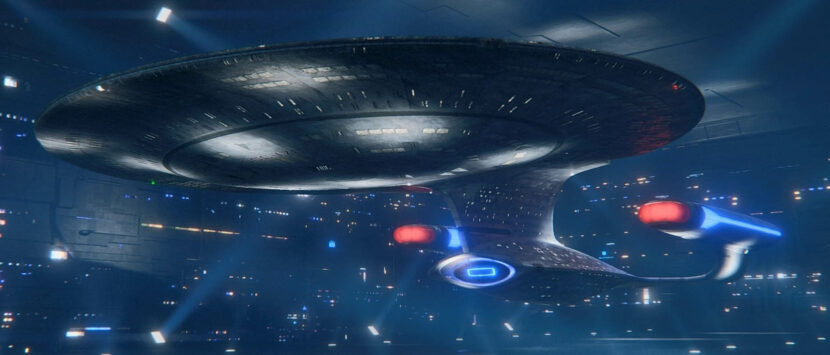
The team is very aware of answering why something is the way it is, so any battle formations or even where the ships are targeting their weapons is all discussed so there is a solid internal logic and things happen for a reason not just because they ‘might look cool’. “Our guiding principle is always balancing realism and drama,” comments Brian. “Everything we do is to bring the most emotion out of the shots – because that’s what services the story. With the end battle, we had to sell the size and scale but still sell the drama and the excitement.”

